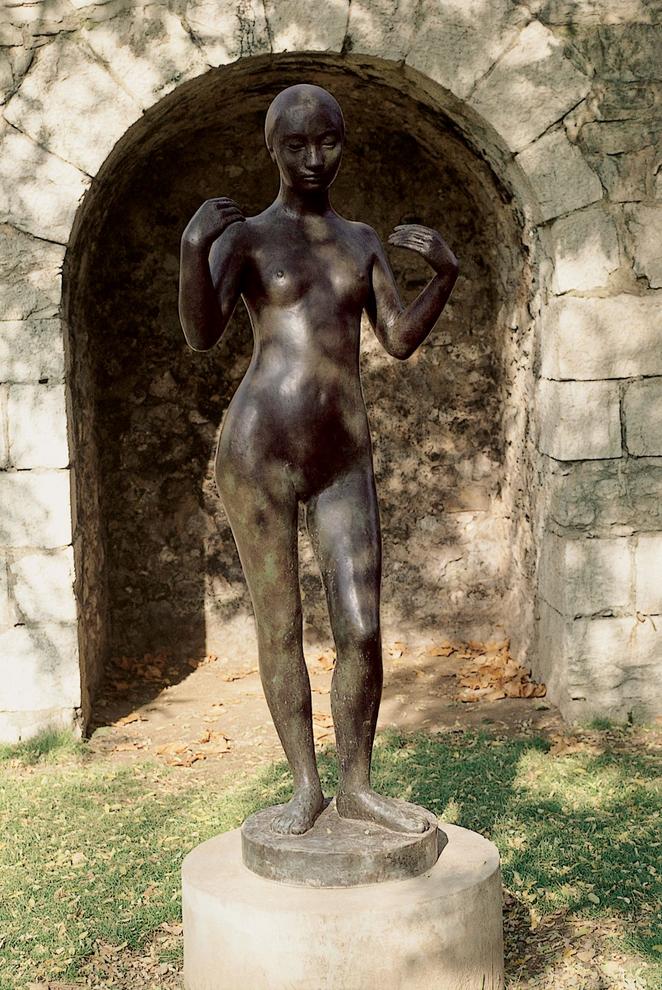
Jeune fille debout, Marcel-Antoine GIMOND

Young Girl Standing, 1928, bronze sculpture by Marcel–Antoine GIMOND (1894-1961)
Located in Albert Michallon Park, Young Girl Standing is a full-length statue of a slender and curvy woman. Once again we can see GIMOND’s interest for Greek sculpture in the so-called “contrapposto” technique he uses for the young girl’s hips: one of her legs is carrying the weight of her body whilst the other is freer and slightly bent.
GIMOND initially worked from life and then re-worked the modelling in order to synthesise line and volume. He studied at the Fine Arts School in Lyon and then up until 1920, worked with the sculptor Aristide Maillol in Marly–Le-Roi. Later, he set up his studio in Paris and exhibited for the first time in 1922 at the Salon des Indépendants and the Salon d'Automne. Despite being highly-respected by his peers he never belonged to any specific artistic group. Indeed, he was too traditional for the avant-garde and too revolutionary for the academy. In 1940, he settled in the South and, in Aix-en- Provence, met up once again with artists who had fled France during the Occupation. After the Liberation, he went back to his studio in Paris. From 1946 to 1961, he taught at the Fine Arts School in Paris in what was known as the “Atelier Gimond”.
This work has been on loan to the town of Grenoble from the National Museum of Modern Art since 1995.
The town of Grenoble has more than 150 works installed in public places that we invite you to discover thanks to several trails across the town and on the grenoble-patrimoine.fr website. These trails have been created with the help of the Département of Isère and the Auvergne-Rhône-Alpes Regional Cultural Affairs Directorate.
Dans le parc Albert Michallon, Jeune fille debout est une statue en bronze de femme en pied, svelte et sinueuse. On retrouve l'intérêt que GIMOND porte à la sculpture grecque dans l’attitude, dite « contrapposto » ou « hanchement », qu’il applique aux hanches de la jeune fille : l'une des deux jambes porte le poids du corps, l'autre étant laissée libre et légèrement fléchie.
GIMOND (1894 - 1961) travaille d'abord d'après nature, puis retouche ensuite le modelage pour trouver une synthèse des traits et des volumes. Il étudie à l'école des Beaux-Arts de Lyon puis collabore jusqu'en 1920 avec le sculpteur Aristide MAILLOL à Marly-Le-Roi. Il s'établit alors à Paris et expose pour la première fois en 1922 au Salon des Indépendants et au Salon d'automne. Malgré le respect que ses pairs lui témoignent, il ne trouve sa place dans aucun groupe artistique : il est en effet trop traditionnel pour l'avant-garde, et trop révolutionnaire pour l'Académie. En 1940, il s'installe en zone Sud, et retrouve à Aix-en-Provence de nombreux artistes qui ont fui la France occupée. A la Libération, il retrouve son atelier à Paris. De 1946 à 1961, il enseigne à l'Ecole des Beaux-Arts de Paris, dans ce que l'on appelait l'" Atelier Gimond ".
Cette œuvre est un dépôt du Musée National d’Art Moderne à la ville de Grenoble en 1995. La Ville de Grenoble compte plus de 150 œuvres implantées sur l’espace public, que nous vous invitons à découvrir à travers plusieurs parcours dans la ville et sur le site grenoble-patrimoine.fr. Ces parcours ont été réalisés avec l’aide du Département de l’Isère et de la Direction Régionale des Affaires Culturelles Auvergne-Rhône Alpes.
Période historique
7ème période : 1968 / aube XXIeClassé en
- Patrimoine Monumental (Artistique, culturel et scientifique)
Thématique(s)
- Art et culture








